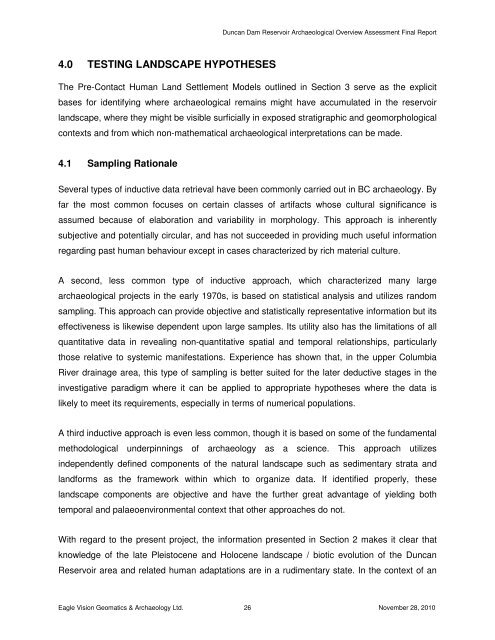November 2010 - BC Hydro
November 2010 - BC Hydro
November 2010 - BC Hydro
You also want an ePaper? Increase the reach of your titles
YUMPU automatically turns print PDFs into web optimized ePapers that Google loves.
4.0 TESTING LANDSCAPE HYPOTHESES<br />
Duncan Dam Reservoir Archaeological Overview Assessment Final Report<br />
The Pre-Contact Human Land Settlement Models outlined in Section 3 serve as the explicit<br />
bases for identifying where archaeological remains might have accumulated in the reservoir<br />
landscape, where they might be visible surficially in exposed stratigraphic and geomorphological<br />
contexts and from which non-mathematical archaeological interpretations can be made.<br />
4.1 Sampling Rationale<br />
Several types of inductive data retrieval have been commonly carried out in <strong>BC</strong> archaeology. By<br />
far the most common focuses on certain classes of artifacts whose cultural significance is<br />
assumed because of elaboration and variability in morphology. This approach is inherently<br />
subjective and potentially circular, and has not succeeded in providing much useful information<br />
regarding past human behaviour except in cases characterized by rich material culture.<br />
A second, less common type of inductive approach, which characterized many large<br />
archaeological projects in the early 1970s, is based on statistical analysis and utilizes random<br />
sampling. This approach can provide objective and statistically representative information but its<br />
effectiveness is likewise dependent upon large samples. Its utility also has the limitations of all<br />
quantitative data in revealing non-quantitative spatial and temporal relationships, particularly<br />
those relative to systemic manifestations. Experience has shown that, in the upper Columbia<br />
River drainage area, this type of sampling is better suited for the later deductive stages in the<br />
investigative paradigm where it can be applied to appropriate hypotheses where the data is<br />
likely to meet its requirements, especially in terms of numerical populations.<br />
A third inductive approach is even less common, though it is based on some of the fundamental<br />
methodological underpinnings of archaeology as a science. This approach utilizes<br />
independently defined components of the natural landscape such as sedimentary strata and<br />
landforms as the framework within which to organize data. If identified properly, these<br />
landscape components are objective and have the further great advantage of yielding both<br />
temporal and palaeoenvironmental context that other approaches do not.<br />
With regard to the present project, the information presented in Section 2 makes it clear that<br />
knowledge of the late Pleistocene and Holocene landscape / biotic evolution of the Duncan<br />
Reservoir area and related human adaptations are in a rudimentary state. In the context of an<br />
Eagle Vision Geomatics & Archaeology Ltd. 26 <strong>November</strong> 28, <strong>2010</strong>

















